INSTITUT SUPERIEUR D'ANTHROPOLOGIE
INSTITUTE OF ANTHROPOLOGY
ONLINE COURSES / COURS A DISTANCE
INSCRIPTION 2012 / Session III : Juillet 2012
REGISTRATION 2012 / Term III : July 2012
USA – 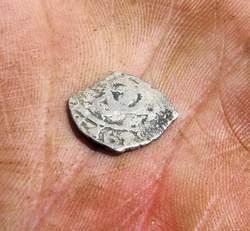 South Berwick - "At first I thought it was just a shell," Whitney Parrish, a University of Southern Maine student from Portland said. "But before I discarded it I sprayed it down with some water and noticed the unique markings." And it's a good thing she wasn't too quick to act on her initial presumption. As it turns out, her irrelevant "shell" turned out to be something much more significant — and historical. What Parrish found was actually a silver Spanish coin known as a real or "piece of eight." Although the coin has indistinct markings and has been severely damaged from several centuries of weathering, the digits 6 and 8 as well as a cross characteristic of Spanish coins from the 1600s and early 1700s indicate it is most likely from this time period. The coin's discovery was made on a parcel of land in proximity to the historic Hamilton House in South Berwick. Many believe the site consisted of a 17th-century dwelling and tavern run by Humphrey and Mary Spencer from about 1696 until 1727. Historical documents also suggest this locale contained a fortified garrison which was used during the conflict-ridden late 1600s and early 1700s. "It was most likely used by citizens during this time period as a defensive structure or stronghold," De Paoli said. "It was probably retrofitted for protection during the Anglo-Indian Wars from 1675 up to around 1720." Although no evidence has been found thus far to indicate the existence of such a stronghold, the team has uncovered foundation stones, clay pipe fragments, and stoneware dishes and flasks. All these support the theory the site was used as tavern three centuries ago.
South Berwick - "At first I thought it was just a shell," Whitney Parrish, a University of Southern Maine student from Portland said. "But before I discarded it I sprayed it down with some water and noticed the unique markings." And it's a good thing she wasn't too quick to act on her initial presumption. As it turns out, her irrelevant "shell" turned out to be something much more significant — and historical. What Parrish found was actually a silver Spanish coin known as a real or "piece of eight." Although the coin has indistinct markings and has been severely damaged from several centuries of weathering, the digits 6 and 8 as well as a cross characteristic of Spanish coins from the 1600s and early 1700s indicate it is most likely from this time period. The coin's discovery was made on a parcel of land in proximity to the historic Hamilton House in South Berwick. Many believe the site consisted of a 17th-century dwelling and tavern run by Humphrey and Mary Spencer from about 1696 until 1727. Historical documents also suggest this locale contained a fortified garrison which was used during the conflict-ridden late 1600s and early 1700s. "It was most likely used by citizens during this time period as a defensive structure or stronghold," De Paoli said. "It was probably retrofitted for protection during the Anglo-Indian Wars from 1675 up to around 1720." Although no evidence has been found thus far to indicate the existence of such a stronghold, the team has uncovered foundation stones, clay pipe fragments, and stoneware dishes and flasks. All these support the theory the site was used as tavern three centuries ago.
http://www.fosters.com/apps/pbcs.dll/article?AID=/20120711/GJNEWS_01/707119950/-1/FOSNEWS
PEROU – 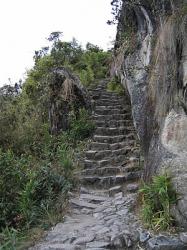 Chakiqocha / Qantupata - A section of the Peru’s Inca Trail was recently discovered in the Cusco region on the country’s southeast side after having been abandoned for about 500 years. Among the surprising amount of orchids and flora, the new section was discovered by Peruvian archaeologists and will reportedly be available to visit in two years, after a research project is conducted. The new section of the trail is about 1.7 meters (about 5’ 7”) wide, 4.3 kilometers (about 2.7 miles) in length, and was built using a retaining wall, rainwater drainage channels, and a paved platform. Archaeologists say about 70 percent of the trail is in very good condition with the rest having been damaged by vegetation and landslides. According to Andina, the new section connects the Chakiqocha part of the trail with the Qantupata archeological site.
Chakiqocha / Qantupata - A section of the Peru’s Inca Trail was recently discovered in the Cusco region on the country’s southeast side after having been abandoned for about 500 years. Among the surprising amount of orchids and flora, the new section was discovered by Peruvian archaeologists and will reportedly be available to visit in two years, after a research project is conducted. The new section of the trail is about 1.7 meters (about 5’ 7”) wide, 4.3 kilometers (about 2.7 miles) in length, and was built using a retaining wall, rainwater drainage channels, and a paved platform. Archaeologists say about 70 percent of the trail is in very good condition with the rest having been damaged by vegetation and landslides. According to Andina, the new section connects the Chakiqocha part of the trail with the Qantupata archeological site.
http://www.hispanicallyspeakingnews.com/notitas-de-noticias/details/new-section-of-inca-trail-discovered-in-peru/17056/
ROYAUME UNI – 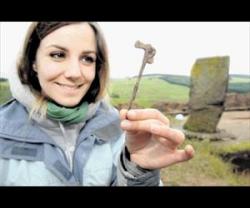 Craw Stane - The discovery of a possible Pictish fort near a north-east village has further strengthened the claim that the site was once an important ancient political settlement. Finds of pottery, bronze pins, glass and amber beads just outside Rhynie last year led archaeologists to the conclusion that the Aberdeenshire site was an important stronghold around AD500. The Rhynie Environs Archaeological Project (REAP) is excavating a new trench at the Craw Stane site, just outside the village, and with the help of aerial photographs they have begun to map out what appears to be the remains of a fort. Aberdeen University’s archaeological lecturer Gordon Noble and Chester University’s Meggen Gondek are leading a team of 12 archaeology students and local volunteers.
Craw Stane - The discovery of a possible Pictish fort near a north-east village has further strengthened the claim that the site was once an important ancient political settlement. Finds of pottery, bronze pins, glass and amber beads just outside Rhynie last year led archaeologists to the conclusion that the Aberdeenshire site was an important stronghold around AD500. The Rhynie Environs Archaeological Project (REAP) is excavating a new trench at the Craw Stane site, just outside the village, and with the help of aerial photographs they have begun to map out what appears to be the remains of a fort. Aberdeen University’s archaeological lecturer Gordon Noble and Chester University’s Meggen Gondek are leading a team of 12 archaeology students and local volunteers.
http://www.pressandjournal.co.uk/Article.aspx/2830038
ROYAUME UNI – 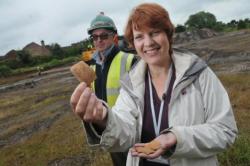 Middlewich - An archaeological dig is currently taking place in Middlewich in a bid to find a Roman cemetery. Experts from Oxford Archaeology North are excavating land in King Street industrial estate and are expected to stay on site until late August. They are also hoping to make discoveries relating to Roman industry. It follows tests on the site in 2008 which revealed evidence of cremation urns. “That gives us a good indication that there’s something there,” said Kerry Fletcher, heritage officer for Middlewich Town Council. “The Romans occupied Middlewich for 400 years so there’s got to be a cemetery somewhere. “It’s a very complex site because as we dig it’s growing and growing in size. “We still don’t know how big the Roman settlement was. This will go some way to answer that question.” Fragments of Roman pottery have already been recovered from the excavation so far which are thought to be from the late 1st century.
Middlewich - An archaeological dig is currently taking place in Middlewich in a bid to find a Roman cemetery. Experts from Oxford Archaeology North are excavating land in King Street industrial estate and are expected to stay on site until late August. They are also hoping to make discoveries relating to Roman industry. It follows tests on the site in 2008 which revealed evidence of cremation urns. “That gives us a good indication that there’s something there,” said Kerry Fletcher, heritage officer for Middlewich Town Council. “The Romans occupied Middlewich for 400 years so there’s got to be a cemetery somewhere. “It’s a very complex site because as we dig it’s growing and growing in size. “We still don’t know how big the Roman settlement was. This will go some way to answer that question.” Fragments of Roman pottery have already been recovered from the excavation so far which are thought to be from the late 1st century.
http://www.middlewichguardian.co.uk/news/9811605.Archaeology_team_search_for_Roman_cemetery_in_Middlewich/
USA – Granger - Indiana conservation officers say a burial ground may be located at a northern Indiana law office where landscapers uncovered buried artifacts including three large monuments, animal remains, and glass. Cpl. Ashlee Jackson says the landscapers uncovered the artifacts Tuesday in Granger, outside South Bend. He says more artifacts at least 140 years old also might be buried there. He says conservation officers have sealed off the area until the Indiana Department of Natural Resources' Division of Historic Preservation and Archaeology can determine all artifacts in the area are preserved. He also says archaeologists may wish to research and excavate the site after receiving a permit from the agency.
http://www.wdrb.com/story/19002703/landscapers-uncover-artifacts-in-granger
ROYAUME UNI – 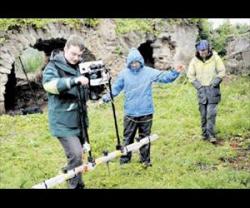 Kinloss Abbey - Persistent rain failed to deter two budding archaeologists at the weekend as they carried out a sophisticated survey of ancient Kinloss Abbey. Archaeologists from ORCA (Orkney Research Centre for Archaeology) taught local youngsters Owen Wheelton and Charlotte Johnson how to use specialist equipment in the hope they might unearth some of the 12th century building’s long-forgotten secrets.
Kinloss Abbey - Persistent rain failed to deter two budding archaeologists at the weekend as they carried out a sophisticated survey of ancient Kinloss Abbey. Archaeologists from ORCA (Orkney Research Centre for Archaeology) taught local youngsters Owen Wheelton and Charlotte Johnson how to use specialist equipment in the hope they might unearth some of the 12th century building’s long-forgotten secrets.
http://www.pressandjournal.co.uk/Article.aspx/2843785
ITALIE – 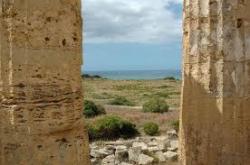 Selinunte - Archaeologists have discovered what may be among the oldest remains at the ancient site of Selinunte: an ancient temple. Inside, fragments have been found that help explain the site's significance: an offering to Demeter, the goddess of grain and agriculture; a small flute, made of bone and dating to 570 BC; a small Corinthian vase. These findings are critically important in helping archeologists to date the temple where they were found, to around the 6th century BC - possibly the oldest in the archaeological area of Selinunte in Sicily. They've been unearthed in recent months by a team led by Clemente Marconi of New York University, working with the Department of Culture and Identity in Sicily and Selinunte Archaeological Park Together, they've also identified the remains of a central colonnade and nearby are pottery shards dated from around 650 BC, including a long vessel decorated with grazing animals. The research confirms assumptions made about the history and age of temple. Particularly significant, researchers say, was the discovery of the flute, which suggests musical performances and dances related to worship of the goddess Demeter, depicted on a series of Corinthian vases found in the area. Researchers still hope to better understand the dimensions and the age of the temple, within the context of the full archeological site of Selinunte.
Selinunte - Archaeologists have discovered what may be among the oldest remains at the ancient site of Selinunte: an ancient temple. Inside, fragments have been found that help explain the site's significance: an offering to Demeter, the goddess of grain and agriculture; a small flute, made of bone and dating to 570 BC; a small Corinthian vase. These findings are critically important in helping archeologists to date the temple where they were found, to around the 6th century BC - possibly the oldest in the archaeological area of Selinunte in Sicily. They've been unearthed in recent months by a team led by Clemente Marconi of New York University, working with the Department of Culture and Identity in Sicily and Selinunte Archaeological Park Together, they've also identified the remains of a central colonnade and nearby are pottery shards dated from around 650 BC, including a long vessel decorated with grazing animals. The research confirms assumptions made about the history and age of temple. Particularly significant, researchers say, was the discovery of the flute, which suggests musical performances and dances related to worship of the goddess Demeter, depicted on a series of Corinthian vases found in the area. Researchers still hope to better understand the dimensions and the age of the temple, within the context of the full archeological site of Selinunte.
http://www.ansamed.info/ansamed/en/news/nations/italy/2012/07/11/Archaeologists-unearth-temple-Demeter-Sicily_7174433.html